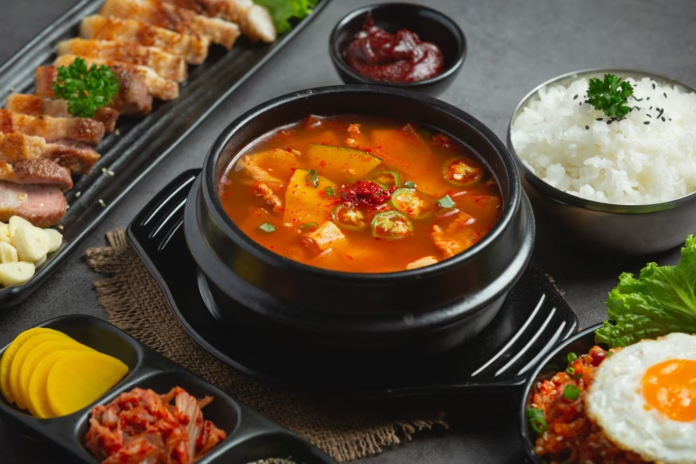Introduction
If you’ve ever found yourself typing “Korean food near me” into your phone while craving something spicy, savory, and incredibly satisfying, you’re not alone. Korean cuisine has seen a massive surge in popularity worldwide, thanks to its unique flavors, colorful presentation, and the global wave of Korean culture. Whether you’re looking for a cozy spot that serves bubbling kimchi jjigae or a late-night eatery with crispy Korean fried chicken, this guide will walk you through what to look for, what to expect, and how to enjoy your next Korean food adventure.
1. What Makes Korean Food So Unique?
Korean food stands out because of its deep use of fermented ingredients, bold spices, and the philosophy of balance. Many dishes are built around rice, fermented vegetables like kimchi, and an assortment of banchan (small side dishes) that bring diversity to each meal. The use of gochujang (spicy red chili paste), doenjang (fermented soybean paste), and sesame oil adds layers of flavor that evolve with each bite. Beyond the flavor, the textures are varied—from crunchy pickled radish to soft tofu—and meals are often communal, designed to be shared. This creates not just a meal, but an experience. Eating Korean food means engaging with the food, mixing, wrapping, and customizing each bite, which makes it both fun and satisfying.
2. Popular Korean Dishes You Should Try Locally
When searching for Korean food nearby, it helps to know what to look for on the menu. One of the most iconic dishes is bibimbap, a rice bowl topped with vegetables, meat, a fried egg, and spicy sauce, all mixed together right before eating. Then there’s bulgogi, thinly sliced marinated beef grilled or pan-fried to perfection, often wrapped in lettuce leaves with garlic and ssamjang sauce. If you like stews, try kimchi jjigae, a spicy kimchi-based soup, or soondubu jjigae, a bubbling tofu stew served in a hot stone pot. And of course, don’t miss out on Korean BBQ, where you grill meats right at your table—a fun and social experience that pairs perfectly with a bottle of soju or Korean beer. These dishes are a great way to start your exploration into Korean cuisine and are typically offered at most Korean restaurants in urban and suburban areas.
3. How to Find Authentic Korean Restaurants Near You
To locate quality Korean food near you, you can start with apps like Yelp, Google Maps, or TripAdvisor. Look for places with good reviews, but also take note of customer photos—authentic Korean restaurants often have metal chopsticks, stone pots, and a wide array of side dishes automatically served with your meal. Another pro tip is to see if the place has a largely Korean customer base, which often signals authenticity. Korean grocery stores often have hidden gems like food courts or small attached eateries, offering home-style meals that are both affordable and genuine. Don’t hesitate to ask staff for recommendations—they’re usually happy to guide newcomers toward the most popular or traditional dishes.
4. The Cultural Experience of Eating Korean Food
Eating Korean food is more than just satisfying your hunger—it’s a cultural experience. Meals are typically shared, emphasizing community and connection. The setting is often casual, but lively, with sounds of sizzling meats, clinking of soju glasses, and laughter all around. In Korean culture, it’s common to eat with friends or family, and to serve each other drinks or help prepare someone’s wrap at the BBQ table. These small customs add to the warmth and enjoyment of the meal. Understanding even a bit of the etiquette—like waiting for the eldest to start eating or not sticking chopsticks upright in your rice—can enhance your experience and show respect to the culture.
5. Vegetarian or Halal? Korean Food Has Options for Everyone
If you follow a vegetarian, vegan, or halal diet, you might think Korean food near me isn’t for you—but that’s not necessarily true. While traditional Korean cuisine often includes beef, pork, or seafood, many restaurants now offer vegetarian versions of classic dishes, such as tofu bibimbap or meatless kimchi (made without fish sauce). Some places even label halal options, especially in multicultural cities. You can also request certain dishes without meat or egg, and many stews can be made with vegetable broth instead. Korean food is incredibly customizable, and once you’re familiar with the ingredients, it becomes easier to navigate the menu to suit your preferences.
6. Bringing the Taste Home: Korean Food Delivery and Takeout
Not in the mood to go out? Many Korean restaurants now offer delivery through apps like Uber Eats, DoorDash, or local platforms. You can enjoy everything from hot bowls of japchae to boxes of Korean fried chicken in the comfort of your own home. Some even provide take-home BBQ kits, letting you recreate the grilling experience with pre-marinated meats and dipping sauces. This convenience has made it easier than ever to enjoy Korean flavors without leaving your couch. Just make sure to reheat dishes properly, especially stews and soups, to keep the textures and flavors intact.


